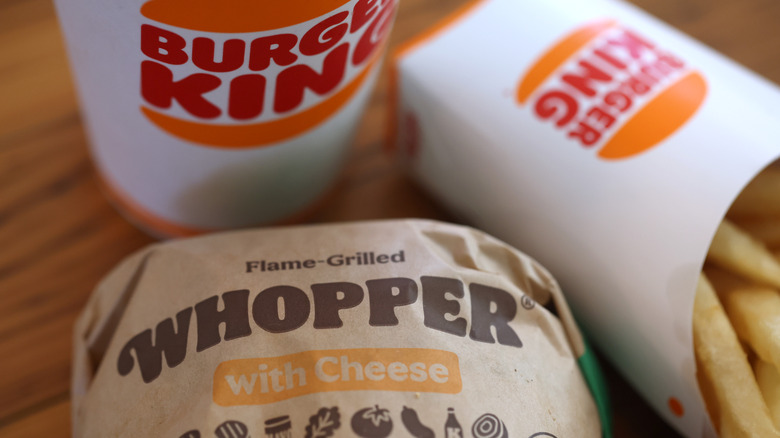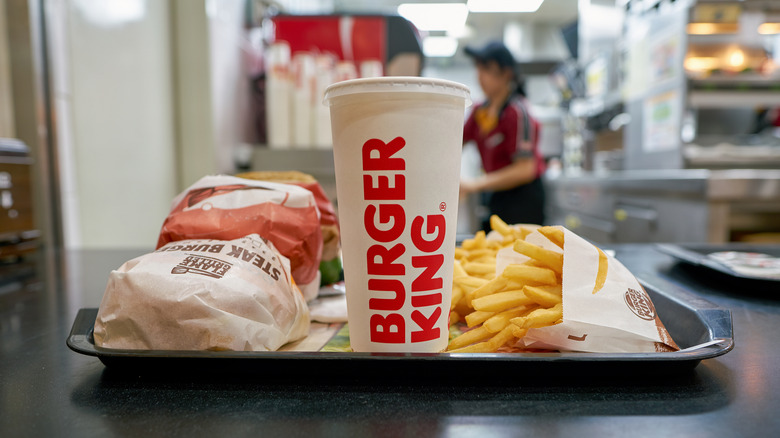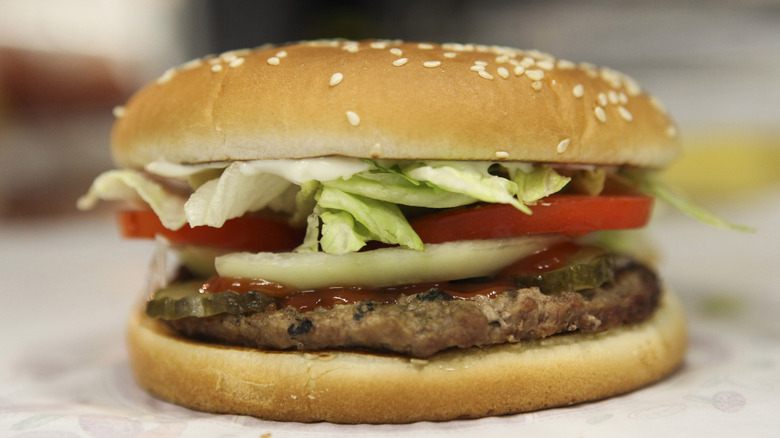The Hatchet Incident That Helped Jump Start Burger King
There are a lot of things to think about when you hear the words "Burger" and "King" in the same sentence. Maybe you think of having something "your way." Maybe you think of flame-broiled beef patties and paper crowns that make you feel like royalty. Maybe you even think of that one "other" Burger King out in Illinois that has nothing to do with kings and Whopper sandwiches (via CBS News). No matter what you think of, hamburger magnate Burger King has left a grill mark-shaped impression on the hearts of fast-food lovers everywhere.
When the franchise's first restaurant opened in 1954, Burger King was initially called a somewhat different name: Insta-Burger King. You see, the Florida-based restaurant had devised a new way to edge into the burgeoning fast-food hamburger business, and that was by offering customers "instant" burgers by way of a special machine known as the "Insta-Broiler." This machine, according to The Burger King Book, would not only quickly and efficiently cook hamburgers much faster than other fry cooks could, but it also provided some free entertainment to customers who could watch the machine automatically "grill" their burgers.
At the time, McDonald's boasted that it had "speedee" service, but Burger King got to claim it had revolutionized the burger industry through technology. Still, Burger King was a far cry from its regal title as the official home of the Whopper. It needed a little "push" to get to where it is today — and that "push," readers, needed a lot of fury and a hatchet.
David Edgerton took a hatchet to the original Insta-Broiler
What do we mean by a "hatchet incident"? Do we refer to some hatchet-wielding maniac dressed like a king who would later serve as the inspiration for the famous Burger King king? Are we talking about an angry franchisee having enough of McDonald's and taking a hatchet to a statue of Ronald McDonald? It would seem that the hatchet incident wasn't a case of man versus man, but man versus machine. According to the New York Times, Burger King founders David Edgerton and James McLamore were having some trouble with their Insta-Broiler machine one day when the discovery was made.
The machine often malfunctioned and broke down, contrasting the promises of it being some sort of "miracle" hamburger machine. While fixing it once or twice may have been no problem, constantly fixing the Insta-Broiler clearly got on the men's nerves — so much so that Edgerton actually took a few swings at it with a hatchet. Thinking the Insta-Broiler needed improvement, and the fact their machine was busted up with a hatchet, McLamore and Edgerton set to work on designing a new addition to Burger King's cooking process.
The Motley Fool tells us that Edgerton and McLamore added a gas grill to the Insta-Broiler, which would "flame-broil" the burgers as they passed over the grill. This would lead to Burger King's proud lifelong tradition of being the only fast-food restaurant to sell flame-broiled hamburgers.
McLamore and Edgerton also invented the Whopper
David Edgerton and James McLamore's initial founding of Burger King would have been enough to add them to the history books. Indeed, the two pioneered what is now one of the most recognizable restaurants in the world. Notably, however, the two can also be traced back as the inventors of Burger King's singular most recognizable meal: the Whopper.
According to the Washington Post, McLamore noticed that a rival hamburger restaurant seemed to be drawing customers away from them. Upon further investigation, McLamore realized that the rival restaurant was selling burgers that were significantly larger than Burger King's. It was at this moment that McLamore made a discovery: He realized that in the fast-food industry, people want more bang for their buck, and it doesn't matter if burgers are flame-broiled or grilled, so long as customers are getting exactly what they want when they want it.
Although he succeeded in creating a "big" burger (one that was 1/4 pound of beef), McLamore still needed a name. He needed something that would convey the idea of something big, so that customers would know that they were going to get something massive right off the bat. The name McLamore settled on, of course, was the Whopper – simply because it had a "big"-sounding name to it. Today, the Whopper remains one of Burger King's core menu items and has become a symbol of the fast-food empire in the process.


